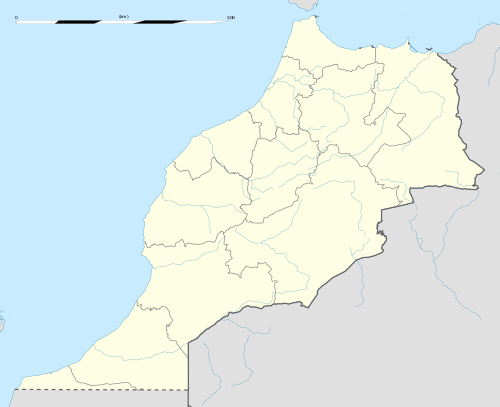Taroudant
Taroudant (Berber languages: Tarudant, ⵜⴰⵔⵓⴷⴰⵏⵜ; Arabic: تارودانت) is a city in the Sous Valley in southern Morocco. It is situated east of Agadir on the road to Ouarzazate and the Sahara desert and south of Marrakesh. The town is known as the "Grandmother of Marrakesh" because it looks like a smaller Marrakesh with its surrounding ramparts. In the sixteenth century, the Saadi dynasty briefly used Taroudant as a capital before it moved its royal seat onwards to Marrakesh. Today, the city has the feel of a small fortified market town on a caravan route.
Taroudant ⵜⴰⵔⵓⴷⴰⵏⵜ تارودانت Tarudant / Rudana | |
|---|---|
.jpg)  Taroudant | |
 Taroudant Location in Morocco | |
| Coordinates: 30°28′15.59″N 8°52′50.16″W | |
| Country | |
| Region | Souss-Massa |
| Province | Taroudant |
| Elevation | 238 m (781 ft) |
| Population (2014)[1] | |
| • Total | 80,149 |
| Time zone | UTC+0 (WET) |
| • Summer (DST) | UTC+1 (WEST) |
| Postal code | 83000 |
Taroudant is known for its local crafts, including jewellery and carpets.
Unlike Marrakesh, almost the entire city of Taroudant is located inside its walls. A new part of the city is being developed outside the city walls around the campus of a faculty of the Ibn Zohr University of Agadir.
History
The town was occupied by the Almoravids in 1056.[2]
A sad event was the massacre of its population by Moulay Ismail in 1687. Under the Alaouites the town resisted royal control. Citizens formed an alliance with Ahmed ibn Mahrez, a dissident nephew of Moulay Ismail.
Today the town is a notable market town and has a souk near each of its two main squares, Assarag and Talmoklate. There is also a weekly souk outside the city walls, near the future university district.[2]
.jpg)
The town walls are nearly 6 kilometres long and are set with bastions and punctuated by nine gates that are still in use.[2] Outside the wall is a small tannery mainly in the business of travel equipment for camel riding, such as goat skin, camel hide sandals, leather bags and belts.
The Berber market, called Jnane al-Jaami, sells spices and dried fruits but mostly clothes and household goods.[2] The Arab souk, however, specializes in handicrafts such as terracotta, wrought iron, pottery, brass and copper, leather and carpets, rugs and jewellery.[2]
References
- "POPULATION LÉGALE DES RÉGIONS, PROVINCES, PRÉFECTURES, MUNICIPALITÉS, ARRONDISSEMENTS ET COMMUNES DU ROYAUME D'APRÈS LES RÉSULTATS DU RGPH 2014" (in Arabic and French). High Commission for Planning, Morocco. 8 April 2015. Retrieved 29 September 2017.
- Morocco. Eyewitness Travel Guides, Dorling Kindersley. 2006. p. 288.
External links
| Wikimedia Commons has media related to Taroudant. |
| Wikivoyage has a travel guide for Taroudannt. |
